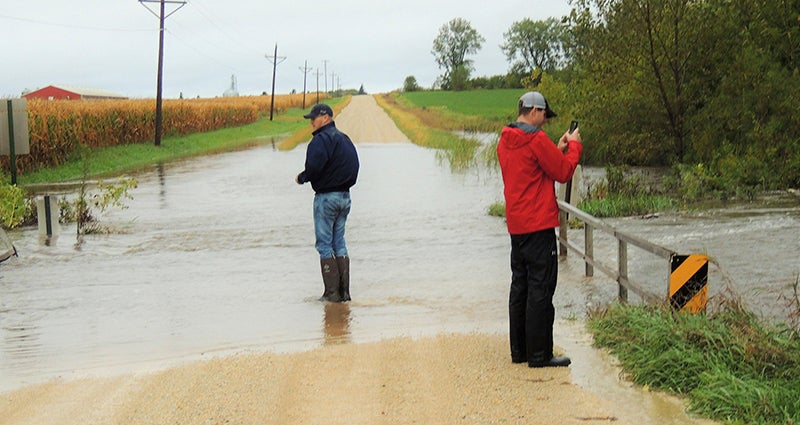A line in the sand against flooding; Community adjusts to routine but resource struggles to maintain
Published 10:14 am Thursday, September 29, 2016

- Aaron Gamm, left, and Cody Fox of the Mower Soil & Water Conservation District check out on the morning of Sept. 22 the North Branch of Dobbins Creek flooding over the 250th Street bridge in Red Rock Township south of Brownsdale. Photo provided
Justin Hanson
Fields Rivers and Streams
A few weeks ago, we were recalling our stories about Austin area’s record 2004 flood. It was Sept. 15, the anniversary date of our community’s worst-known flood.
Cedar River Watershed District staff had posted a few photos of the 2004 flood on Facebook, and the community responded with comments and recollections of where they were and how the flood affected them.
A week later, we were out in the countryside, taking inventory and water samples in response to another major September flood that occurred overnight — the seventh worst-known flood for the Cedar River in Austin and third-worst for Turtle Creek in Austin.
As we worked our way down the Cedar River and its tributaries, we met numerous citizens sharing their stories about various flood events. They pointed out landmarks of where water had reached previously compared to where it was that day. We speculated together about how far it would go up. Most noted they were prepared for the day, as they had taken precautions or knew what to do if the waters kept rising.
In the afternoon last Thursday, we met with one of our cooperators. He and his family have land on Orchard Creek and Rose Creek. He spoke with us for a while about the rising waters and potential damage, and then wrapped up our discussion with a seemingly passing comment: “Well, we better start sandbagging.”
His tone was similar to if I was telling my neighbor it was time to mow my lawn.
The laid-back approach to flooding in our community intrigues me. The water is causing property and field damage all over yet the general response is usually calm and routine. It occurs to me that this flooding business is far too routine.
While the community evolves to make 25-, 50- and 100-year floods “routine,” the fact remains that our property, fields and natural resources continue to be dramatically affected by these events. Flood damage is much more than the things we see going under water. Township roads, bridges and property stand out to all of us who took inventory of the last flood. But there is considerable resource damage being done, and some of this is not as visible as washed out roads and wet basements.
We were a bit lucky that this fall flood came when crops were holding the farm land together. The excessive rate at which floods come on and move through our watershed system, however, is creating significant challenges to the water quality and sustainability of our natural resources.
Floods bring velocity of water, running off the landscape and creating havoc in its wake. In this last flood, field runoff resulted in thousands of tons of dirt that no longer is on the land and has been displaced downstream. A nearly equal amount of dirt has been washed out of the streambanks, changing the dynamics of streams and degrading the biological bugs and fish that rely on these waterways for existence. When the entire system is degraded, the effects and consequences go far outside the scope of our homes, roads and bridges.
Our community’s residents have evolved into tough, flood veterans and calmly have adapted to the crazy frequency of these events. It’s a great reflection of their character.
Equally impressive is the local support for improving our current challenges. The Cedar River Watershed District is committed to working with our stakeholders in the agricultural community and the folks in cities to implement projects that will start reducing the effected that flood flows have on our land and waterways.
CRWD is working hard with farmers and rural landowners on a series of capital projects that will hold water on the land and reduce the amount of soil runoff to our streams. With the continued support of our landowners, CRWD will invest about $8.4 million over the next few years into projects focused on clean water and flood reduction. Our efforts will not end with this initiative, and the work will need to go beyond the initial kickoff of these capital projects. But we’re making intentional efforts to utilize the best science available and start building projects that will make a difference.
Routine flooding presents great challenges to the land and water. We feel, however, that it’s a challenge well worth the effort and investment. Our natural resources will be here long past us, as will our flooding challenges.
I think it’s an exciting time for all of us as a watershed community to draw a line in the sand and commit to making progress toward reducing flood damage and improving water quality.
Mower SWCD provides technical assistance to landowners with conservation practices that protect land and water resources. SWCD also administers the Cedar River Watershed District to improve water quality and reduce flooding. This column runs monthly on the last Thursday. For more, visit the Mower SWCD and CRWD websites and Facebook pages. Comments can be sent to tim.ruzek@mowerswcd.org.
Justin Hanson is the manager of the Mower Soil & Water Conservation District and administrator of the Cedar River Watershed District .


